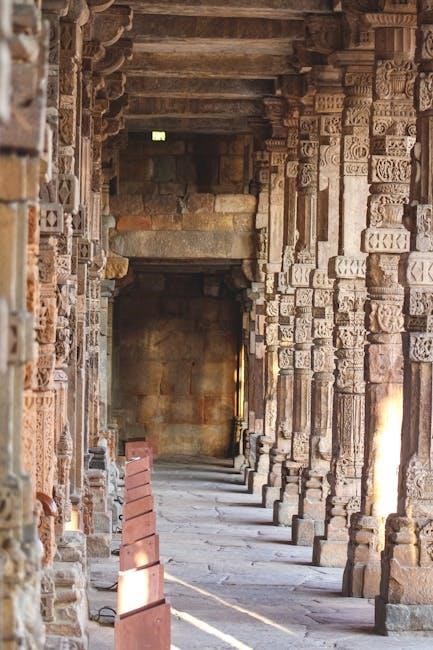The UL V497 design specifies a 1-hour fire-rated wall assembly, typically constructed with steel stud framing and gypsum board, ensuring compliance with fire safety standards.
1.1 Overview of UL V497 Design
UL V497 outlines a fire-rated wall assembly designed for 1-hour fire resistance. It typically includes steel stud framing with specific gauge requirements and gypsum board installation. The assembly ensures fire resistance and safety, complying with ANSI/UL 263 standards. It is suitable for various applications, including commercial and residential buildings, offering both structural integrity and fire protection. The design incorporates detailed construction features to meet safety and performance criteria, making it a reliable choice for fire-rated partitions and shaftwall assemblies.
1.2 Importance of UL Ratings in Construction
UL ratings are critical for ensuring fire safety and compliance with building codes. They provide third-party verification that materials and assemblies meet rigorous safety standards. This certification is essential for engineers, architects, and contractors to ensure compliance with fire-resistance requirements. UL ratings also reduce liability, ensuring reliable performance in emergency conditions. By adhering to UL standards, constructions meet recognized safety benchmarks, fostering trust among stakeholders and ensuring the integrity of fire-rated assemblies like those specified in UL V497.

Key Features of UL V497
UL V497 specifies fire-rated wall assemblies with steel studs, gypsum board, and fire-shield materials, ensuring 1-hour fire resistance and structural integrity for safe construction practices.
2.1 Fire-Rated Wall Assembly Specifications
UL V497 outlines fire-rated wall assemblies with a 1-hour rating, incorporating steel studs (minimum 3-5/8″ wide) and gypsum board for enhanced fire resistance and structural stability.
2.2 Steel Stud Framing Requirements
Steel studs for UL V497 must be at least 3-5/8″ wide, with 25-gauge (15 mil) or 20-gauge (18-20 mil) EQ studs, ensuring proper load-bearing capacity and fire resistance.
2.3 Gypsum Board Installation Details
The UL V497 design requires gypsum boards to be installed with a minimum width of 3-5/8″ and securely fastened to steel studs. Ensure a tight fit at joints and use appropriate sealants for fire resistance. Boards must be continuous, with no gaps, and edges aligned properly. Fasteners should be spaced evenly, and all cutouts must be sealed to maintain the assembly’s integrity and fire rating performance.

Fire Resistance and Safety
The UL V497 design ensures walls meet fire-resistance standards, providing 1-hour ratings, and complies with ANSI/UL 263 for enhanced safety in commercial and industrial applications.
3.1 Fire-Resistance Ratings for Walls
The UL V497 design achieves a 1-hour fire-resistance rating for walls, ensuring structural integrity and flame containment. It meets ANSI/UL 263 standards, verifying its performance in fire scenarios. This rating is crucial for commercial and industrial applications, where safety and durability are paramount. The assembly’s fire-resistance is validated through rigorous testing, providing peace of mind for architects and builders. Compliance with these standards ensures reliability and adherence to safety regulations.
3.2 Compliance with ANSI/UL 263 Standards
UL V497 adheres to ANSI/UL 263 standards, which govern fire-resistance ratings for building materials. This ensures the assembly withstands fire exposure, maintaining structural integrity and insulation. Compliance verifies the system’s ability to endure high temperatures without compromising safety. Architects and builders rely on this certification to meet regulatory requirements and ensure occupant safety in commercial and industrial settings. The testing process evaluates the assembly’s performance under fire conditions, confirming its reliability and adherence to industry benchmarks.
3.3 Acoustical Performance and STC Ratings
UL V497 assemblies provide excellent acoustical performance, with STC ratings ranging from STC-34 to STC-48, ensuring effective sound transmission control. These ratings are determined through rigorous testing, confirming the system’s ability to minimize noise transfer between spaces. The design incorporates materials and construction methods that enhance soundproofing, making it suitable for environments requiring both fire safety and acoustical insulation. This dual functionality adds value for commercial, industrial, and residential applications, where both safety and sound control are critical. The specifications are detailed in the UL V497 PDF for precise implementation;

Construction and Design Details
UL V497 requires a minimum 3-5/8″ wide steel stud framing with 25-gauge or 20-gauge studs, ensuring structural integrity and fire resistance, along with 5/8″ fire-shield materials.
4.1 Minimum Steel Stud Width and Gauge
The UL V497 design specifies a minimum steel stud width of 3-5/8 inches, with acceptable gauges being 25-gauge (15 mil) or 20-gauge (18-20 mil). These studs are considered equivalent gauge (EQ) and must be used in conjunction with 5/8-inch fire-shield materials to meet fire-resistance requirements. The design also outlines specific installation details for gypsum board, ensuring a secure and fire-rated assembly. Compliance with these specifications is critical for achieving the desired fire and acoustical performance, including STC ratings.
4.2 Fire-Shield Requirements
UL V497 specifies that fire-shield materials must be installed to maintain fire-resistance ratings. A minimum of 5/8-inch fire-shield materials is required, ensuring proper protection in wall assemblies. These materials must be securely fastened to steel studs, with no gaps that could compromise fire integrity. The design emphasizes strict adherence to these requirements to achieve the desired fire-resistance ratings and ensure compliance with safety standards, as outlined in the UL V497 documentation and related fire-testing protocols.
4.3 Head of Wall Construction
The head of wall construction in UL V497 requires specific detailing to ensure fire-resistance continuity. A minimum of 2 1/2″ steel studs and 5/8″ fire-shield materials are mandated for head-of-wall assemblies. These components must be securely fastened and sealed to prevent fire penetration. Proper alignment and installation are critical to maintain the integrity of the fire-rated system, as detailed in UL V497 documentation. This ensures compliance with fire-resistance standards and maintains structural stability at wall intersections.

Applications and Use Cases
UL V497 is widely used in commercial and industrial settings for fire-rated walls, shaftwall assemblies, and partitions, providing effective fire and sound barriers essential for safety and compliance.
5.1 Commercial Building Applications
UL V497 is commonly used in commercial buildings for fire-rated walls, partitions, and shaftwall assemblies. Its 1-hour fire rating ensures safety in high-traffic areas, such as offices, malls, and hospitals. The design supports load-bearing and non-load-bearing structures, offering flexibility for various architectural needs. By providing effective fire resistance and acoustic performance, UL V497 enhances both safety and comfort in commercial environments, making it a preferred choice for modern construction projects requiring durability and compliance with fire safety standards.
5.2 Industrial and Residential Uses
UL V497 is versatile for industrial and residential applications, offering fire-rated solutions for walls and partitions. In industrial settings, it is used for fire-rated assemblies separating manufacturing areas and control rooms. For residences, it is ideal for multi-family housing, such as apartments and condos, providing fire containment and noise reduction between units. The design supports both load-bearing and non-load-bearing structures, ensuring safety and compliance with fire and acoustical standards in diverse building types.
5.3 Shaftwall and Partition Assemblies
UL V497 is commonly used in shaftwall and partition assemblies to provide fire containment between floors and rooms. These assemblies are critical in high-rise buildings and multi-unit residential structures, ensuring fire resistance and acoustic separation. The design accommodates both load-bearing and non-load-bearing configurations, making it suitable for various construction needs. Its compliance with fire safety standards ensures reliable performance in containing fire and noise between units, enhancing overall building safety and occupant protection.

Testing and Certification
UL V497 undergoes rigorous testing and certification to ensure compliance with fire and safety standards. Acoustical performance is verified through standardized tests, with detailed documentation provided for compliance.
6.1 UL Certification Process
The UL certification process involves rigorous testing and evaluation to ensure compliance with fire resistance standards. Products must meet specific criteria for fire-rated assemblies, including structural integrity and material performance. The certification process includes laboratory tests, inspections, and documentation reviews. UL certification is recognized as a mark of safety and reliability, ensuring that products meet or exceed industry standards. The process is comprehensive, covering all aspects of fire-rated wall assemblies like UL V497.
6.2 Acoustical Testing Methods
Acoustical testing for UL V497 involves measuring sound transmission loss to determine STC (Sound Transmission Class) ratings. Tests are conducted in accordance with ASTM standards E90 and E413. Variables such as material types, installation methods, and stud gauges are evaluated. The process ensures soundproofing performance meets specified criteria. STC ratings like STC-34, STC-38, and STC-48 are commonly referenced. These tests are crucial for verifying the effectiveness of soundproofing in fire-rated assemblies, ensuring compliance with acoustical standards.
6.4 Documentation and Compliance
UL V497 documentation includes detailed PDF guides, CAD files, and Revit models, ensuring compliance with fire and acoustical standards. Proper documentation is essential for verifying that assemblies meet UL certification and ANSI/UL 263 requirements. Compliance ensures safety and regulatory adherence, with resources available for planning and execution. Accurate documentation also aids in avoiding material compatibility and installation issues, ensuring the assembly performs as intended for fire resistance and soundproofing.

Advantages of UL V497 Design
UL V497 offers enhanced fire safety, improved soundproofing, and durable structural integrity, making it a reliable choice for fire-rated wall assemblies in various construction projects.
7.1 Enhanced Fire Safety
UL V497 ensures enhanced fire safety by providing a 1-hour fire-rated wall assembly, designed to withstand fire exposure and prevent its spread. Constructed with gypsum board and steel studs, this assembly meets stringent fire-resistance standards, ensuring safety in commercial and industrial applications. Compliance with ANSI/UL 263 further guarantees reliability, making it a trusted solution for fire-rated constructions.
7.2 Improved Soundproofing
UL V497 assemblies offer improved soundproofing with STC ratings ranging from STC-34 to STC-48, ensuring effective noise reduction. The design combines gypsum board and steel studs to minimize sound transmission, making it ideal for commercial and industrial applications. By addressing variables like material thickness and installation methods, UL V497 enhances acoustical performance while maintaining fire safety, providing a balanced solution for modern constructions.
7.3 Durability and Structural Integrity
UL V497 assemblies ensure durability and structural integrity through robust steel stud framing and gypsum board installation. The minimum 3-5/8″ wide steel studs and fire-resistant materials provide long-lasting performance. Designed for both load-bearing and non-load-bearing applications, these assemblies withstand environmental and structural stresses, maintaining their integrity over time. Compliance with ANSI/UL standards guarantees reliability, making them suitable for various construction projects requiring both strength and safety.

Resources and Downloads
Access UL V497 PDF, CAD files, Revit models, and technical specifications for fire-rated wall assemblies. These resources provide detailed construction and design guidance for professionals.
8.1 Accessing UL V497 PDF
The UL V497 PDF is available on the UL website, providing detailed specifications for 1-hour fire-rated wall assemblies. This document includes construction features, material requirements, and compliance guidelines. To access it, visit the official UL resources section and submit a request. The PDF is essential for architects, contractors, and builders to ensure proper installation and adherence to fire safety standards. Additional resources like CAD files and Revit models are also available for download.
8.2 CAD Files and Revit Models
CAD files and Revit models for UL V497 are available for download on the UL website, supporting precise design and planning. These resources provide detailed layouts for 1-hour fire-rated wall assemblies, including steel stud dimensions and gypsum board configurations. Architects and contractors can use these files to ensure compliance with UL standards and streamline construction documentation. Formats such as DWG and RVT enable seamless integration into project designs, facilitating accurate installations and compliance verification.
8.3 Technical Specifications and Guides
Technical specifications and guides for UL V497 provide detailed requirements for fire-rated wall assemblies, including steel stud framing, gypsum board installation, and fire-resistant materials. These documents outline compliance with UL fire-resistance standards, ensuring structural integrity and safety. Guides also cover material compatibility and installation best practices, helping contractors meet UL certification criteria. They are essential for designing and constructing walls that adhere to UL V497 standards, ensuring both fire safety and structural performance in various building applications.

Limitations and Considerations
UL V497 fire-rated wall assemblies may have limitations, including load-bearing capacity restrictions and material compatibility issues. Installation challenges must be addressed to ensure compliance with fire-resistance standards.
9.1 Load-Bearing vs. Non-Load Bearing Walls
UL V497 fire-rated wall assemblies are designed for both load-bearing and non-load-bearing applications; Load-bearing walls must meet specific structural requirements, while non-load-bearing walls focus solely on fire-resistance. The design ensures compatibility with various construction materials, adhering to safety standards. Proper installation is crucial to maintain fire-resistance ratings and structural integrity. Compliance with UL standards is essential for both types, ensuring reliability in fire-rated assemblies.
9.2 Material Compatibility Issues
Material compatibility is critical in UL V497 assemblies. Incompatible materials can compromise fire-resistance and structural integrity. Steel studs must be paired with approved gypsum boards to maintain ratings. Issues arise when non-specified materials, such as certain fasteners or sealants, are used. Adherence to UL guidelines ensures material compatibility, preventing potential failures. Proper selection and verification of materials are essential to meet safety and performance standards in fire-rated assemblies.

9.3 Installation Challenges
Installation of UL V497 assemblies requires precision to ensure fire-resistance and structural integrity. Challenges include maintaining proper seals, aligning steel studs accurately, and avoiding gaps that compromise ratings. Incorrect fasteners or sealants can void certifications. Special attention is needed for head-of-wall details and fire-shield placement. Non-compliant materials or improper techniques can lead to inspection failures. Training and adherence to UL guidelines are essential to overcome these challenges and achieve a safe, durable assembly.
UL V497 provides a reliable solution for fire-rated assemblies, ensuring safety and compliance. Its versatility in commercial and residential applications makes it a preferred choice for builders and architects.
10.1 Summary of UL V497 Benefits
UL V497 offers enhanced fire resistance, ensuring safety in commercial and residential applications. Its design provides improved soundproofing and structural integrity, making it durable and versatile. Compliance with ANSI/UL 263 standards guarantees reliability, while its compatibility with various construction materials simplifies installation. The assembly’s fire-rated performance and acoustic efficiency make it a preferred choice for architects and builders seeking cost-effective, high-performance solutions for modern buildings.
10.2 Future Trends in Fire-Rated Assemblies
Future trends in fire-rated assemblies, like UL V497, are expected to focus on advanced materials and sustainable designs. Innovations in gypsum board and steel framing may enhance fire resistance and acoustic performance. Integration with eco-friendly materials and smart technologies could improve safety and efficiency. These developments aim to meet growing demands for high-performance, environmentally conscious building solutions while maintaining compliance with evolving fire safety standards and regulations.





